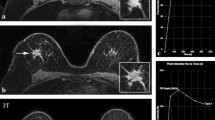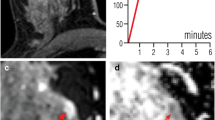Abstract
Objective
The objective of our study was to evaluate the clinical application of bilateral high spatial and temporal resolution dynamic contrast-enhanced magnetic resonance imaging (HR DCE-MRI) of the breast at 7 T.
Methods
Following institutional review board approval 23 patients with a breast lesion (BIRADS 0, 4–5) were included in our prospective study. All patients underwent bilateral HR DCE-MRI of the breast at 7 T (spatial resolution of 0.7 mm3 voxel size, temporal resolution of 14 s). Two experienced readers (r1, r2) and one less experienced reader (r3) independently assessed lesions according to BI-RADS®. Image quality, lesion conspicuity and artefacts were graded from 1 to 5. Sensitivity, specificity and diagnostic accuracy were assessed using histopathology as the standard of reference.
Results
HR DCE-MRI at 7 T revealed 29 lesions in 23 patients (sensitivity 100 % (19/19); specificity of 90 % (9/10)) resulting in a diagnostic accuracy of 96.6 % (28/29) with an AUC of 0.95. Overall image quality was excellent in the majority of cases (27/29) and examinations were not hampered by artefacts. There was excellent inter-reader agreement for diagnosis and image quality parameters (κ = 0.89–1).
Conclusion
Bilateral HR DCE-MRI of the breast at 7 T is feasible with excellent image quality in clinical practice and allows accurate breast cancer diagnosis.
Key points
• Dynamic contrast-enhanced 7-T MRI is being developed in several centres.
• Bilateral high resolution DCE-MRI of the breast at 7 T is clinically applicable.
• 7-T HR DCE-MRI of the breast provides excellent image quality.
• 7-T HR DCE-MRI should detect breast cancer with high diagnostic accuracy.



Similar content being viewed by others
References
Sardanelli F, Boetes C, Borisch B et al (2010) Magnetic resonance imaging of the breast: recommendations from the EUSOMA working group. Eur J Cancer 46:1296–1316
Turnbull LW (2009) Dynamic contrast-enhanced MRI in the diagnosis and management of breast cancer. NMR Biomed 22:28–39
Orel SG, Schnall MD (2001) MR imaging of the breast for the detection, diagnosis, and staging of breast cancer. Radiology 220:13–30
Schnall M, Orel S (2006) Breast MR imaging in the diagnostic setting. Magn Reson Imaging Clin N Am 14:329–337, vi
Morrow M, Waters J, Morris E (2011) MRI for breast cancer screening, diagnosis, and treatment. Lancet 378:1804–1811
DeMartini W, Lehman C (2008) A review of current evidence-based clinical applications for breast magnetic resonance imaging. Top Magn Reson Imaging 19:143–150
Kinkel K, Helbich TH, Esserman LJ et al (2000) Dynamic high-spatial-resolution MR imaging of suspicious breast lesions: diagnostic criteria and interobserver variability. AJR Am J Roentgenol 175:35–43
Liberman L, Morris EA, Lee MJ et al (2002) Breast lesions detected on MR imaging: features and positive predictive value. AJR Am J Roentgenol 179:171–178
Kuhl CK, Schild HH, Morakkabati N (2005) Dynamic bilateral contrast-enhanced MR imaging of the breast: trade-off between spatial and temporal resolution. Radiology 236:789–800
Baltzer PA, Benndorf M, Dietzel M, Gajda M, Runnebaum IB, Kaiser WA (2010) False-positive findings at contrast-enhanced breast MRI: a BI-RADS descriptor study. AJR Am J Roentgenol 194:1658–1663
Dietzel M, Baltzer PA, Vag T et al (2010) Differential diagnosis of breast lesions 5 mm or less: is there a role for magnetic resonance imaging? J Comput Assist Tomogr 34:456–464
Gutierrez RL, DeMartini WB, Eby PR, Kurland BF, Peacock S, Lehman CD (2009) BI-RADS lesion characteristics predict likelihood of malignancy in breast MRI for masses but not for nonmasslike enhancement. AJR Am J Roentgenol 193:994–1000
Pinker K, Grabner G, Bogner W et al (2009) A combined high temporal and high spatial resolution 3 Tesla MR imaging protocol for the assessment of breast lesions: initial results. Invest Radiol 44:553–558
Pinker-Domenig K, Bogner W, Gruber S et al (2012) High resolution MRI of the breast at 3 T: which BI-RADS(R) descriptors are most strongly associated with the diagnosis of breast cancer? Eur Radiol 22:322–330
Elsamaloty H, Elzawawi MS, Mohammad S, Herial N (2009) Increasing accuracy of detection of breast cancer with 3-T MRI. AJR Am J Roentgenol 192:1142–1148
Schmitz AC, Peters NH, Veldhuis WB et al (2008) Contrast-enhanced 3.0-T breast MRI for characterization of breast lesions: increased specificity by using vascular maps. Eur Radiol 18:355–364
Kuhl CK, Jost P, Morakkabati N, Zivanovic O, Schild HH, Gieseke J (2006) Contrast-enhanced MR imaging of the breast at 3.0 and 1.5 T in the same patients: Initial experience. Radiology 239:666–676
Rahbar H, Partridge SC, DeMartini WB, Thursten B, Lehman CD (2013) Clinical and technical considerations for high quality breast MRI at 3 Tesla. J Magn Reson Imaging 37:778–790
van de Bank BL, Voogt IJ, Italiaander M et al (2012) Ultra high spatial and temporal resolution breast imaging at 7 T. NMR Biomed. doi:10.1002/nbm.2868
Korteweg MA, Veldhuis WB, Visser F et al (2011) Feasibility of 7 Tesla breast magnetic resonance imaging determination of intrinsic sensitivity and high-resolution magnetic resonance imaging, diffusion-weighted imaging, and (1)H-magnetic resonance spectroscopy of breast cancer patients receiving neoadjuvant therapy. Invest Radiol 46:370–376
Brown R, Storey P, Geppert C et al (2013) Breast MRI at 7 Tesla with a bilateral coil and T1-weighted acquisition with robust fat suppression: image evaluation and comparison with 3 Tesla. Eur Radiol 23:2969–2978
Stehouwer BL, Klomp DW, van den Bosch MA et al (2013) Dynamic contrast-enhanced and ultra-high-resolution breast MRI at 7.0 Tesla. Eur Radiol 23:2961–2968
Wijnen JP, van der Kemp WJ, Luttje MP, Korteweg MA, Luijten PR, Klomp DW (2011) Quantitative (31) P magnetic resonance spectroscopy of the human breast at 7 T. Magn Reson Med 68:339–348
Klomp DW, van de Bank BL, Raaijmakers A et al (2011) 31P MRSI and 1H MRS at 7 T: initial results in human breast cancer. NMR Biomed 24:1337–1342
Umutlu L, Maderwald S, Kraff O et al (2010) Dynamic contrast-enhanced breast MRI at 7 Tesla utilizing a single-loop coil: a feasibility trial. Acad Radiol 17:1050–1056
Stehouwer BL, Klomp DW, Korteweg MA et al (2013) 7 T versus 3 T contrast-enhanced breast magnetic resonance imaging of invasive ductulolobular carcinoma: first clinical experience. Magn Reson Imaging 31:613–617
Baltzer PA, Dietzel M, Vag T et al (2011) Clinical MR mammography: impact of hormonal status on background enhancement and diagnostic accuracy. RöFo 183:441–447
DeMartini WB, Liu F, Peacock S, Eby PR, Gutierrez RL, Lehman CD (2012) Background parenchymal enhancement on breast MRI: impact on diagnostic performance. AJR Am J Roentgenol 198:W373–W380
Han BK, Schnall MD, Orel SG, Rosen M (2008) Outcome of MRI-guided breast biopsy. AJR Am J Roentgenol 191:1798–1804
Solin LJ, Orel SG, Hwang WT, Harris EE, Schnall MD (2008) Relationship of breast magnetic resonance imaging to outcome after breast-conservation treatment with radiation for women with early-stage invasive breast carcinoma or ductal carcinoma in situ. J Clin Oncol 26:386–391
Kuhl CK, Mielcareck P, Klaschik S et al (1999) Dynamic breast MR imaging: are signal intensity time course data useful for differential diagnosis of enhancing lesions? Radiology 211:101–110
Insko EK, Connick TJ, Schnall MD, Orel SG (1997) Multicoil array for high resolution imaging of the breast. Magn Res Med 37:778–784
Solomon B, Orel S, Reynolds C, Schnall M (1998) Delayed development of enhancement in fat necrosis after breast conservation therapy: a potential pitfall of MR imaging of the breast. AJR Am J Roentgenol 170:966–968
Schueller G, Jaromi S, Ponhold L et al (2008) US-guided 14-gauge core-needle breast biopsy: results of a validation study in 1352 cases. Radiology 248:406–413
Degnim AC, King TA (2013) Surgical management of high-risk breast lesions. Surg Clin North Am 93:329–340
Mann RM, Veltman J, Huisman H, Boetes C (2011) Comparison of enhancement characteristics between invasive lobular carcinoma and invasive ductal carcinoma. J Magn Reson Imaging 34:293–300
Mann RM, Loo CE, Wobbes T et al (2010) The impact of preoperative breast MRI on the re-excision rate in invasive lobular carcinoma of the breast. Breast Cancer Res Treat 119:415–422
Weinstein SP, Orel SG, Heller R et al (2001) MR imaging of the breast in patients with invasive lobular carcinoma. AJR Am J Roentgenol 176:399–406
Kuhl CK, Schrading S, Bieling HB et al (2007) MRI for diagnosis of pure ductal carcinoma in situ: a prospective observational study. Lancet 370:485–492
Lehman CD (2010) Magnetic resonance imaging in the evaluation of ductal carcinoma in situ. J Natl Cancer Inst Monogr 2010:150–151
Mann RM, Kuhl CK, Kinkel K, Boetes C (2008) Breast MRI: guidelines from the European Society of Breast Imaging. Eur Radiol 18:1307–1318
Baltzer PA, Dietzel M, Kaiser WA (2011) Nonmass lesions in magnetic resonance imaging of the breast: additional T2-weighted images improve diagnostic accuracy. J Comput Assist Tomogr 35:361–366
Acknowledgments
Funding was provided by the Austrian Nationalbank ‘Jubiläumsfond’ Project 5082.
Author information
Authors and Affiliations
Corresponding author
Rights and permissions
About this article
Cite this article
Pinker, K., Bogner, W., Baltzer, P. et al. Clinical application of bilateral high temporal and spatial resolution dynamic contrast-enhanced magnetic resonance imaging of the breast at 7 T. Eur Radiol 24, 913–920 (2014). https://doi.org/10.1007/s00330-013-3075-8
Received:
Revised:
Accepted:
Published:
Issue Date:
DOI: https://doi.org/10.1007/s00330-013-3075-8




